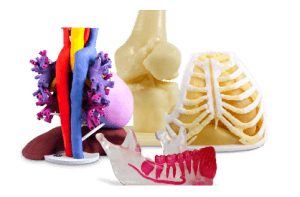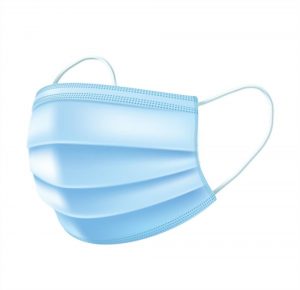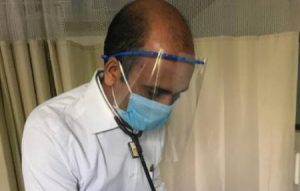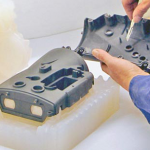
The 3D printing industry is evolving and it is perceived as a rapidly maturing prototyping technology. The 3D printing market offers multiple applications in the medical field and helps the medical & pharmaceutical industries to produce more medical products, medical implants & drugs.
The unanticipated and rapid proliferation of covid-19 pandemic has shaken the total world and left more demand for medical equipment & drug supplies in the healthcare industries across the world. At the time of need, major manufacturers of 3D printing and members of the 3D community had helped in supporting the production of medical equipment & vital supplies to save many lives.
It has been forecast that 3D printing in medical technology was valued at $713.3m in 2016, and then it was valued at $973 million in 2018. In 2020, 3D printers played a major role in the revenue side of the market growing at a CAGR of 17.25% throughout the forecast period. Few reports say that the worth of 3D technology in health care is expected to reach $4,070.8 million by 2027.
Materials used in 3D printing for healthcare supplies
A wide variety of biomaterials are being used to develop & create 3D structures, the biomaterials used here are polymeric biomaterials, hydrogel, ceramic-based, and composites. All biomaterials have their specific properties and mechanical properties, which vary based on their size and stiffness. It is biocompatible and has adequate degradation kinetics.
The most commonly used biomaterial in 3D printing technology is polymers because it is formed of filaments for fused deposition modeling (FDM), and they can easily go with direct ink writing (DIW). Popularly known and used polymers in 3D printing technology are Acrylonitrile butadiene styrene (ABS), Polylactic acid (PLA), High-performance polymers (PEEK), Polycaprolactone (PCL) Polyamides, Thermoplastic polyurethane (TPU), Polypropylene (PP), and Polycarbonate (PC).
Bio inks are referred to as printable hydrogels which are suitable for bioprinting and should ensure and fulfill the requirements such as inkjet is under modest pressures, whether it jellifies quickly, and have proper mechanical properties. Hydrogel inks are made from collagen, fibrin, gelatin, spider silk, matrigel, alginate, methylcellulose, chitosan, and k-carrageenan. Ceramic-based materials such as hydroxyapatite and calcium phosphates are used in orthopedics and dental surgery due to their high stiffness.
Overall, the future 3D printing perspectives on healthcare supplies are developed and reached a greater level, which is ready to expand for modern medicine through a personalized way to save more lives and improve the performances in the healthcare systems.
Applications of 3D Printing in the healthcare field
Advances in 3D printing technology led the way to save more lives & amplified the healthcare field. Every year, 3D printing has been applied to many needs of the healthcare industry and it is also an early adopter of 3D printing. The various applications include customized implants, neurosurgery, orthopedic surgery, radiation oncology, urology, vascular surgery, transplant surgery, plastic surgery, and oral & maxillofacial surgery.
Covid-19 caused more demand for medical & specialized products in the healthcare field. In the time of need, 3D printing filled the gap and increased the production of medical devices & supplies.
Thanks to the 3D printing domain for offering more & more help in the current crisis of covid-19 pandemic and the key applications of healthcare and clinical field are as follows:
1. 3D bioprinting of tissues & organoids
3D bioprinting offers the most promising approach to the huge demand for organ transplantation. Since 2010, the demand for organ donors has increased doubled coupled with a more number of patients in need of organs for transplantation. Bioprinting technology creates living tissues such as blood vessels, bones, skins, hearts, etc.
Researchers like Dr. Sam Pashneh-Tala from the University of Sheffield have brought new prospects to tissue engineering for the development of 3D bioprinting. Bioprinters with the help of tissue engineering & regenerative medicine form a layer-by-layer assembly of biomaterials in a 3D pattern.
The bioprinting approach involves four typical processes, the first one is digital light processing (DLP) using planar projection, the second one is fused deposition modeling (FDM), the third process is a stereolithography (STL) file format, and the fourth one is selective laser sintering (SLS).
In the first process, it tends to manufacture tissue structures without biocompatibility needs, and in the second process creates non-degradable products with biocompatibility requirements.
The third process is to assemble the biocompatibility structures and degradable products (For example, fabricating active ceramic bone and biodegradable vascular stent), and the fourth process is to manipulate living cells to construct 3D tissues such as cell models. And, the fourth process of bioprinting can also be called cell printing.
2. 3D printing used for customized surgical instruments
3D printing provides more beneficial opportunities in healthcare systems by manufacturing customized implants, surgical tools, or instruments. It helps the surgeon by giving a 3D model of the desired patient anatomy which is used for planning the surgical approach & creating customized prosthetics or surgical instruments. All needed prosthetics are modeled based on patient-specific anatomy.
3D printing manufactures orthopedic implants that are better-fitting, longer-lasting, and higher-performing implants. And, the first 3D-printed implant was manufactured around 2007. With the help of 3D printing technology, a wide range of implants can be manufactured such as hip, knee, skull, and spinal implants. The main advantages of functional 3D-printed surgical instruments are adequate structural strength and easy assembly. Time constraints and the cost of manufacturing the surgical instruments gets minimal. A few reports state that 600,000 implants were produced with 3D printing in 2019 and it is also estimated that by 2027 it will be around five million.

3. 3D printing is helping to fight covid-19 pandemic
The outbreak of the 2019 Coronavirus disease (COVID-19) resulted in an ongoing pandemic crisis and affected over 200 countries around the globe. The covid-19 crisis led to logistical challenges in the manufacturing and transportation of medical supplies, equipment including personal protection equipment (PPE), and isolation wards. Healthcare systems are caught up in a crucial struggle, to overcome this demand, and manufacturers referred to 3D printing in association with the healthcare systems. Various key designs have been altered and redesigned to match the desired 3D requirements to battle against covid-19.
3D printing technology is being used to manufacture medical supplies and equipment including safety goggles, oxygen valves, nasal swabs, masks, shields, quarantine booths, ventilators, door handle management, and respirators. And, the 3D-printed devices are categorized into prevention, treatment, and diagnosis equipment based on their functionalities.
Therefore, it leads to more benefits of 3D printing in healthcare systems including more efficiency, faster performance, reduction in manufacturing costs, few errors, minimal waste generation, and low cost.
4. 3D printed Face masks for covid-19 pandemic
As the covid-19 pandemic crisis increased resulted in huge demand for PPE in the year 2019. However, the facemasks slow down the spread of the disease and prevent the transmission of viruses.
The World Health Organization (WHO) warns the government and healthcare systems to provide facemasks for the general public and medical masks for healthcare workers. To avoid this demand, the major manufacturers of the individual 3D community started designing reusable facemasks with 3D printing technology.
Commonly, there are two respiratory safety devices, which are masks and respirators. Masks are soft, flexible, and loose-fitting safety devices, and on the other hand, respirators are hard, rigid, tight-fitting safety devices. The masks can be referred to as fabric masks (it can be any kind of cloth) used by the common individual to prevent the airborne transmission of the virus from spreading to others while we talk, sneeze, or cough. Respirators have industry-rated filter mediums, that are used to filter harmful particles from the incoming air.
In the market, the two main face mask frames are CEG Extreme and the GE Additive community frame which is available for NIH print exchange and community use. The CEG Extreme face mask frames are applicable for people working in grocery stores, pharmacies, restaurants, and law enforcement. The community uses design masks for individuals to prevent patients diagnosed with covid-19. Best-printed frames are usually made from PLA and PETG, some theories state that PETG is preferable because of its nature (i.e. durability and flexibility).
In optimizing the print settings for the face mask frames, first, check for the size of the frame whether it is thin or thick, and make sure that the frames should be strong. If the mask frame is thin it’s important to increase the number of perimeters to 4 or more to make it stronger. In the making of the CEG frame using 3D printing technology, the fabric pegs will be removed during use. To build these pegs stronger, should reset the percentage to 100% at the start of the peg in the variable settings wizard.

Assembly of prints into a 3D face mask
Once the printing is over, 3D facemasks are assembled by the following processes are as follows:
- Cutting the fabric material: In this process, the fabric being cut is more than the given perimeter of the mask, and check with all the available or more materials that tend to achieve a desired comfortable fit.
- Testing: The mask is fully assembled only after attaching the straps to it, and now check for comfort & fit after wearing the mask. If the fitting does not follow the contours of the face up to the bridge of the nose, try a scale method for a better fit. Make sure that the frame masks should not have gaps.
- Disinfect: Always disinfect the mask by bleaching the frame mask in 10% of bleach solution for 5 minutes, when you decide to donate the mask to others.
5. 3D-printed face shields for covid-19 pandemic
The 3D printing domain continually helps the medical field and individuals across the globe to overcome the shortages of PPE by producing and providing the equipment needed for healthcare systems. The most needed equipment required for healthcare workers is the face shield, which is simple and easy to assemble. The National Institute of Health has partnered with America to support healthcare workers by designing face shields and these designs are reviewed and approved by the FDA and the VA.
The three main components of the face shield are a visor, a shield, and a strap. The woven elastic band which is used to hold the shield should be ½’’wide for the desired comfort and fit. The visor can be printed in either PLA or PETG, mostly PETG is preferred due to its reusable property, additional heat resistance, flexibility, and durability. And, the ideal materials used for making the shield are polycarbonate, propionate, acetate, and polyethylene terephthalate glycol (PETG). All the materials vary in their properties and behavior when cutting, and bending.
In the optimization of the print settings, the two main factors such as balancing speed and integrity should be considered. When there is an increase in the production of the number of face shields, there occurs an issue in optimizing the layout. Commonly, the attachment points of the face shield will create thin walls and small tabs which can be made stronger with the proper settings.
These face shield models with several areas contain thin wall settings, which are filled with the correct amount of material using the “Allow single extrusion walls” and “Allow single extrusion fill” options. The face shield model with a larger flat surface is allowed to warping, and one of the simplest ways to secure the print is by skirt or brim.

Assembly of prints into the 3D face shield
Once the printing is over, 3D face shields are assembled and distributed by the following processes are as follows:
- Testing: To test the part integrity and flexibility of the 3D face shield, flex the visor several inches in all directions and listen for any break or splitting of layers that indicate that a specific part has inadequate infill. Visor materials should be gently flexed with greater strength.
- Disinfect: Always disinfect the mask by bleaching the frame mask in 10% of bleach solution for 5 minutes, when you decide to donate the mask to others.
- Distribution: All these face shields and devices after disinfecting are ready to distribute across the globe to save more & more lives. The final process is the most promising and challenging, these face shields should be distributed to all the people who need them.
How does NexGen 3D help in the battle against the Covid-19 pandemic?
NexGen 3D is the best 3D printing organization with 30 years of experience in printing production which captured the attention of the country by manufacturing & donating face shields and supplied over 50,000 to front-line workers in law enforcement, sanitation department, grocery stores, and pharmacies.
NexGen 3D has collaborated with multinational leading companies to donate over and oversupplies around 1 lakh to doctors across our country. Initially, face shields are made through 3D printing, but later we went for injection mounding. And, we are the official resellers of 3D printers in southern India. Even Chief Minister Stalin and the health minister have been seen wearing our face shields. As of now, we have manufactured over 20000 face shields per day at our facility.
Ms. Padmaja Padarthi is an experienced co-founder of NexGen 3D printers with a demonstrated history of working in the mechanical industry had helped manufacturers in making masks using CoLIDo printers and supplied over 10 lakh face shields. We are proud to say that NexGen 3D is one of the first companies to launch and get European certification (CE certificate). NexGen 3D printing provides services like strategic planning, 3D designs, cloud management, and outsourcing.



